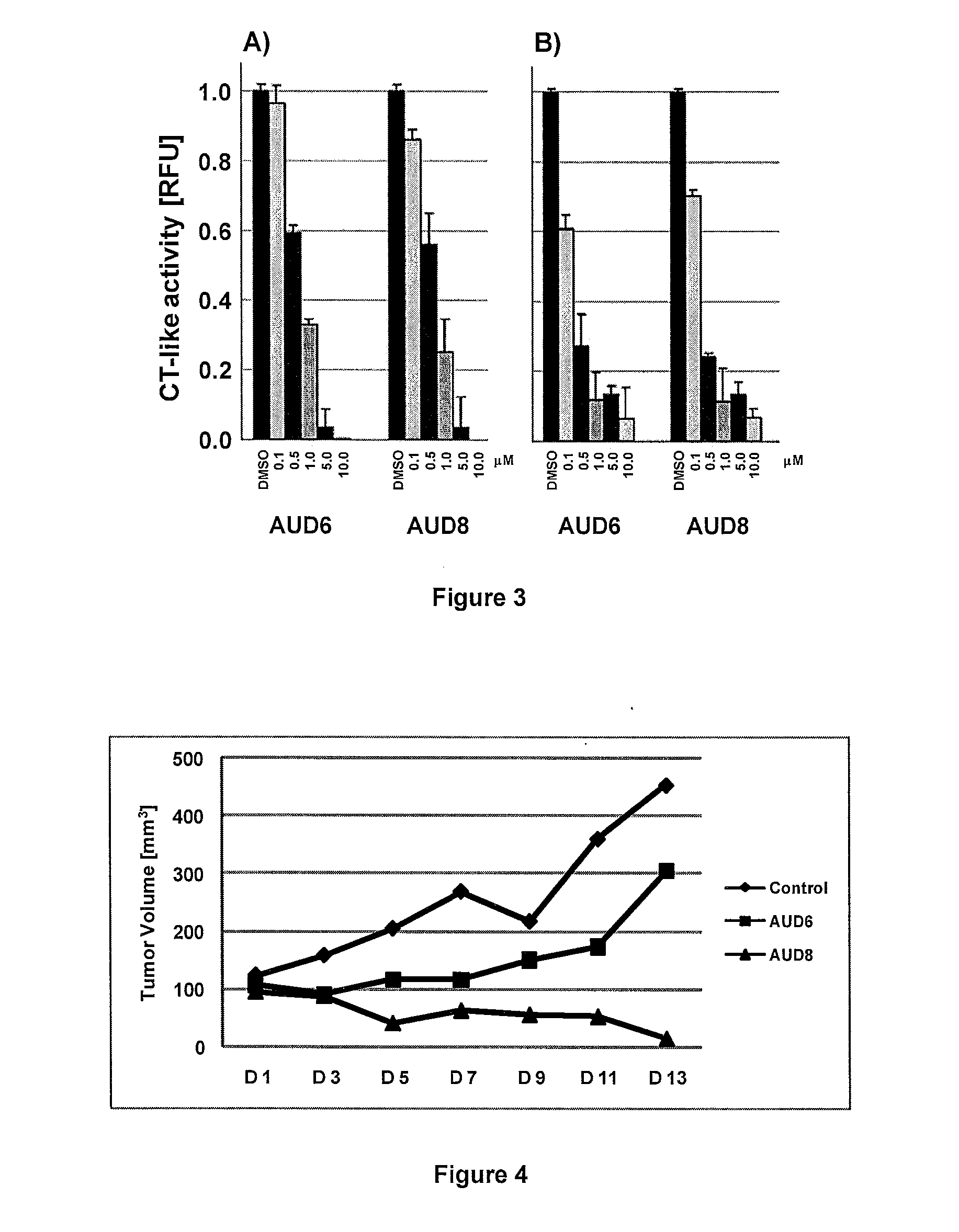Gold (III) complexes with oligopeptides functionalized with sulfur donors and use thereof as antitumor agents
a technology of oligopeptides and complexes, which is applied in the field of gold (iii)dithiocarbamato derivatives with oligopeptides, can solve the problems of limited neurotoxicity is a major drawback, and the use of kidney toxicity limits the use of cisplatin and related platinum-based therapies, so as to improve intracellular drug transfer and delivery, the effect of lack
- Summary
- Abstract
- Description
- Claims
- Application Information
AI Technical Summary
Benefits of technology
Problems solved by technology
Method used
Image
Examples
example 1
[AuIIIBr2((t-Bu)O-Gly-Sar-dtc)] (AUD6)
[0066]A water solution (ca. 3 mL) of HCl.H-Sar-Gly-O(t-Bu) (1.42 mmol) cooled at 0° C. was drop-wise treated under continuous stirring with cool CS2 (1.43 mmol) and an aqueous solution (1 mL) of NaOH (1.42 mmol). When pH turned from 11 to 6 after ca. 2 h, the solution was slowly added under stirring to an aqueous cool (0° C.) solution (ca. 2 mL) of K[AuBr4] (0.70 mmol), leading to the immediate precipitation of a reddish-brown solid that was filtered off, washed with water, and dried under reduced pressure with P2O5, the final yield being 77.2%.
[0067]Elemental analyses calculated for C10H17AuBr2N2O3S2: C, 18.94; H, 2.70; N, 4.42; S, 10.11%. Found: C, 19.20; H, 2.88; N, 4.42; S, 10.25%.
[0068]Melting point: the complex decomposes at 152.6° C.
[0069]IR data (KBr, cm−1): 3352 (v, N—H); 1736 (v, C═O ester); 1673 (v, C═O amide); 1568 (v, amide II+N—CSS); 1253 (v, amide III); 1228 (v, C—O(t-Bu)); 1161 (v, (t-Bu)—O); 1006, 556 (va,s, S—C—S); 387 (va,s, S...
example 2
[AuIIICl2((t-Bu)O-Gly-Sar-dtc)] (AUD7)
[0072]A water solution (ca. 3 mL) of HCl.H-Sar-Gly-O(t-Bu) (1.56 mmol) cooled at 0° C. was drop-wise treated under continuous stirring with cool CS2 (1.58 mmol) and an aqueous solution (1 mL) of NaOH (1.58 mmol). When pH turned from 11 to 6 after ca. 2 h, the solution was slowly added under stirring to an aqueous cool (0° C.) solution (ca. 2 mL) of K[AuCl4] (0.77 mmol), leading to the immediate precipitation of a yellow-ochre solid that was filtered off, washed with water, and dried under reduced pressure with P2O5, the final yield being 76.9%.
[0073]Elemental analyses calculated for C10H17AuCl2N2O3S2: C, 22.03; H, 3.14; N, 5.14; S, 11.76%. Found: C, 22.00; H, 3.23; N, 5.08; S, 11.96%.
[0074]Melting point: the complex decomposes at 155.3° C.
[0075]IR data (KBr, cm−1): 3349 (v, N—H); 1737 (v, C═O ester); 1672 (v, C═O amide); 1561 (v, amide II+N—CSS); 1253 (v, amide III); 1229 (v, C—O(t-Bu)); 1162 (v, (t-Bu)—O); 1006, 558 (va,s, S—C—S); 384 (va,s, S—...
example 3
[AuIIIBr2((t-Bu)O-Aib-Sar-dtc)] (AUD8)
[0078]A water solution (ca. 3 mL) of HCl.H-Sar-Aib-O(t-Bu) (1.43 mmol) cooled at 0° C. was drop-wise treated under continuous stirring with cool CS2 (1.43 mmol) and an aqueous solution (1 mL) of NaOH (1.42 mmol). When pH turned from 11 to 6 after ca. 2.5 h, the solution was slowly added under stirring to an aqueous cool (0° C.) solution (ca. 2 mL) of K[AuBr4] (0.71 mmol), leading to the immediate precipitation of a reddish-brown solid that was filtered off, washed with water, and dried under reduced pressure with P2O5, the final yield being 76.4%.
[0079]Elemental analyses calculated for C12H21AuBr2N2O3S2: C, 21.76; H, 3.20; N, 4.23; S, 9.68%. Found: C, 22.03; H, 3.33; N, 4.34; S, 9.58%.
[0080]M.p.: decomposes at 165.9° C.
[0081]IR data (KBr, cm−1): 3362 (v, N—H); 1734 (v, C═O ester); 1690 (v, C═O amide); 1560 (v, N—CSS); 1531 (v, amide II); 1252 (v, amide III); 1215 (v, C—O(t-Bu)); 1144 (v, (t-Bu)—O); 996, 545 (va,s, S—C—S); 383 (va,s, S—Au—S); 252...
PUM
| Property | Measurement | Unit |
|---|---|---|
| pH | aaaaa | aaaaa |
| pH | aaaaa | aaaaa |
| tumor resistance | aaaaa | aaaaa |
Abstract
Description
Claims
Application Information
 Login to View More
Login to View More - R&D
- Intellectual Property
- Life Sciences
- Materials
- Tech Scout
- Unparalleled Data Quality
- Higher Quality Content
- 60% Fewer Hallucinations
Browse by: Latest US Patents, China's latest patents, Technical Efficacy Thesaurus, Application Domain, Technology Topic, Popular Technical Reports.
© 2025 PatSnap. All rights reserved.Legal|Privacy policy|Modern Slavery Act Transparency Statement|Sitemap|About US| Contact US: help@patsnap.com



